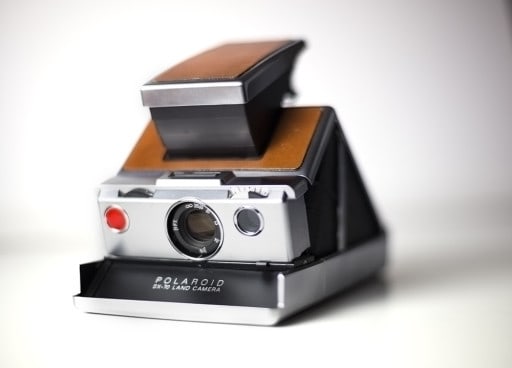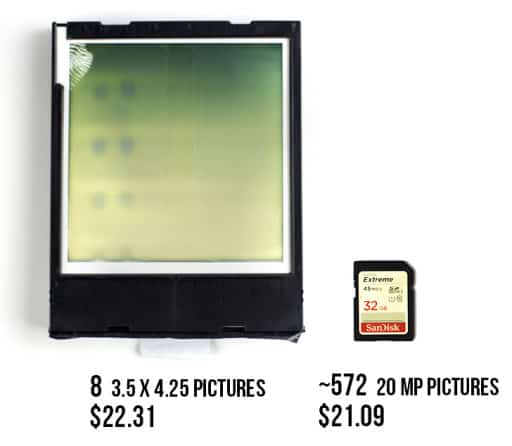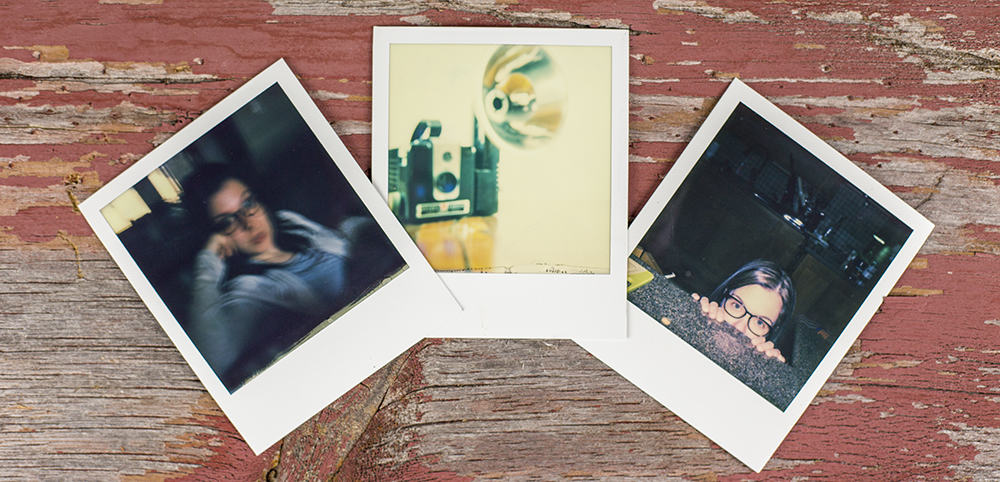Back to the Future with the Polaroid SX 70 Land Camera
About a week ago I won an Auction (with the help of Jake McCluskey) on eBay for a Polaroid SX 70 Land Camera. This may not be a big deal to you or you may even have one already, but it is an item I have always wanted in my camera inventory. I collect old cameras, especially the beefy metal body ones. Every time I am at a thrift store and see one I get anxiety and have to have it. Whether it works or not it doesn’t matter to me, I just enjoy the cameras for the pictures they once captured and the stories they once told.

I mentioned the Polaroid SX 70 Land Camera is one I have always lusted for. In years past the Polaroid SX 70 Land Camera was a marvel of its time for professional photographers. It was not uncommon for professionals to carry around a Polaroid Camera alongside their SLR gear so they could see the scene in print long before the film was developed. Even Ansel Adams carried around a Polaroid camera. His version was a Type 55 that was capable of the quick print along with a Large Format reusable negative.
My goal for owning a Polaroid was not to be like the greats that walked before me, but to enjoy the tactile nature of the print. In this day and age where we take so many photographs we fail to print them half as much as we make them. This is a shame, really. I am at fault here too, I think I printed 15 pictures last year and 3 were gifts. I just don’t think about printing all too often.
I was shocked that I could still find film for SX 70 Type Land Camera’s. I guess there is a big niche here that is larger than I expected as the supply is pretty high on Amazon for SX 70 Film. I have purchased 4 cartridges of film for this Land Camera and another One Step Polaroid that I purchased from a thrift store and they work great! One thing about the Polaroid Land Camera types is the battery is in the film cartridge and not in the camera itself. This means you can usually get a good deal on SX 70 cameras as their owners seldom think they operate due to dead batteries.
The shocking price of tactile photos
When I first looked into film for the SX 70 I was shocked by the price tag, $22 for 8 pictures… geez! Now I can understand why I was scolded at the young age of 8 for taking so many Polaroid Pictures of my Legos. Could you imagine if you had to spend over $20 on 8 pictures these days? We’d all be broke and the hobby of digital photography would have a much smaller devoted following. I compared an SD card that costs roughly the same as a SX 70 film cartridge. The Sandisk 32 Gigabyte SD card gets approximately 570 twenty megapixel pictures per use and you don’t have to buy it again when it “runs out”. So why on earth would I still be buying Polaroid film?

The tactile nature of the Polaroid print is so much fun. Really that is the only way I can describe it. There is something undeniably awesome about the snapping of the shutter and the immediate sound of motors printing your most recent capture. You don’t need to download it, don’t need to process it, and don’t have to send it to a printer. It is right there immediately in your hand.
Since these 8 captures are so precious at almost $3 per picture you become much more selective about what you shoot. I used a whole “roll” in the first hour of owning it just to see how it worked and shortly after I felt ashamed of myself for wasting $20 on pictures of random objects around the house (to include my wife, but she’s not random).

Where am I going with this?
I have an idea. You see I am always experimenting with every type of photography and this kind is really interesting. There is much more to the Polaroid and I find that every cartridge I open yields a new Instamatic or even Instagram type of look. As I experiment with the Polaroid SX 70 Land Camera I am coming to several findings.
- I am much more deliberate about what I shoot with it.
This mindset should find its way into my Digital Photography which means less time taking bad photos. Some people say there is no such thing, but trust me there is. When we have unlimited exposures we limit our time composing saying, “I’ll just toss it later” … then why take it in the first place? - I am enjoying the natural Instamatic effects of the prints.
I am not quite sure what yields the Instamatic look, whether it is the lighting at the time or the film cartridge being used or a combination of both. However, I am documenting the looks I receive in Photoshop Actions and now Color Lookup Tables. It is one thing to use a filter or a preset, but it is another to study those presets long before they are created to better understand what is happening to the photo in the process. - History becomes less of a mystery.
I picked up a camera back in 1999 that was my first experience with photography. I had a Canon AE-1, I loved it and treasured it as my Mom handed it down to me when she upgraded. It got me through many years of film classes in High School and helped me understand an art form I had not yet taken on. However, I was not as interested in it as much as I was painting and sculpting so I didn’t study it half as much as I’d have liked. Now I feel like I am going back in time to study things I never put an effort toward. - I am much more grateful for what we have now.
You saw the price of the film for the SX 70 Land Cameras, $22 for 8 prints. Last year I shot a total of 3981 photos that would be about $11,102 in Polaroid prints. The reality is I only spent a fraction of that on Memory cards and extra camera batteries. We live in a time where access to great things is only a click away both on the internet and on the camera. I know I have often overlooked that and now I am much more grateful for the technology and what it provides us.









I have an SX 70 and it has been idle for a long while. I’m tickled to know there are film packs still available.The color pallette for this film is special.
The color Palette is amazing. It is giving me so many ideas for photos in the digital world.
I found a, never used, Polaroid in the box with all the extras in my dad’s closet when he passed four years ago. Guess what, it’s in my close now along with my Canon AE 1 from my Vietman days.
Oh man! I have 2 Canon AE-1’s. My first was given to me by my Mom in 1999 (the start of photo for me) the second I bought at a Thrift Store for $5!
If you haven’t already, checkout https://www.the-impossible-project.com.
Great resource for Polaroid stuff, they just wanted far too much money than Iwas willing to spend for an SX 70
I also got the kick and purchased a couple SX70’s with the intent of using them for film manipulation which was popular about ten years ago. What you would do is take a picture and then almost immediately start to “jazz up” the image on the print with a variety of tools, thereby, creating an “impressionistic” feeling on the print. Each of these manipulations would be a “one of a kind” as it was difficult to reproduce the exact circumstances.
I remember that! My Step Mom has an awesome one of a Sunflower in the house. It was blown up from the original and turned into a digital print. I am currently experimenting with emulsion lifts right now. Very fun stuff!
Polaroid is to photography what vinyl is to recording: too good to die, Now, if we could just get Kodachrome back.
I have several of these cameras. I was very involved with a lot of the Polaroid films and processes in the past. Unfortunately Polaroid film is no longer available since the demise of the company. The film you are using is either long expired or is from the impossible project which is making a valiant effort to make film for Polaroid cameras, but it is a far cry from the original films.
Joel
Jeez…I wish I had known you wanted one, I had an Sx70, the last of the polaroid cameras I had, sitting in the attic dust collecting. No one wanted it when I asked around and it wound up in a donation box. Polaroids were fun and you always could reshoot something immediately if your first shot left something to be desired rather than finding out that you didn’t get the shot you wanted when film was developed. However, prints didn’t stand the test of time too well. I spent days scanning old Polaroid prints and restoring them not too long ago.
I still have a marvelous 180 Land, which I was using as a test camera, when I was shooting fashion with my Nikon F, in the ’70. With the 180 Land I had complete control over the aperture (the lens is a sharp 114mm./f.4,5 Tominon) and shutter speed (1sec to 1/500). This gave me the ability to shoot with the same parameters I was going to apply to my Nikons and therefore I was able to check if everything was perfect (light, background, model, etc.), before starting the real shooting. In those times, you used to give a Polaroid picture of each scene you were going to take, to the fashion editor, who was supervising the photo session. She used to clip every Polaroid picture to her scrapbook, in shooting order so, at the end of the day, she could go back to her magazine and show to the picture editor, how the work will look. It is a fantastic metal camera, with a Zeiss folding viewfinder, as well as the bellow which connect the lens to the body. Once everything is collapsed, the camera is self contained in its own detachable cover. I have never used it since I retired. I know Fuji is still producing a FP-3000B b&W film which also produce a negative which can be used as is!
I think the reason it is easy to find film for the instant cameras is because, construction contractors use them. At least that is my guess. I have seen them at Home Depot.
I had one decades ago. It was wide and fairly shallow. I had to role on some kind of was on the print to preserve it.
I wish I still had it, might be worth money as an antique.
“role on wax”